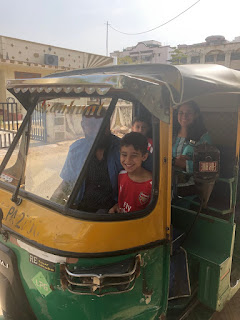John's world-
Foodie Nirvana…
Between Brinda and I, we have a good several decades worth
of making Indian food. Over the years,
we learned to make a decent curry, a nice chapatti, and some butter chicken
that can stack up well against any restaurant.
We thought we “knew” Indian cuisine.
For Valentine’s Day we decided we wanted to do a shared
experience as a gift to each other.
Airbnb had some incredible experiences to try out. Crafts to make, market walks, even bar crawls
all looked like a great way of spending some time with someone you love. What caught our eye though was an Indian
cuisine cooking class. We thought “why
not”. Maybe there will be a couple of
things we might not have known about.
We were wrong.
We learned A LOT more than what we ever could have imagined
about Indian cooking.
Our hostess Geeta was, as it turns out, a food
scientist. Her research involved going
around various parts of India and researching different recipes for
dishes. She would note differences in
spice combinations, techniques, and other ingredients. Suffice it to say, she knew what she was
talking about.
Due to time constraints (we needed to pick up the kids),
Geeta was gracious enough to accommodate us for the morning rather than the
afternoon.
After a wonderful breakfast, we got right into our lesson. As I looked over the plate of spices I
though, “I know this”. Maybe one spice I
wasn’t able to identify (stoneflower).
While I might have known the spice, I sure was in for an education about
how to properly use it.
Geeta explained to us that each herb or spice contributes
not only a flavor but also some kind of characteristic effect on the human
body. For example a chile producing not
just a hot flavor but also aiding in digestion.
To get the most out of each spice both in flavor and bodily effect, one
must also use it at the right time. For
most of the dishes we cooked there were three additions of spice. A base like additions usually cooked in an oil,
a middle addition, and a finishing addition.
Most spices fall into one of these three categories and has a “job” to
do in the dish. The spices are not there
to show off, but rather are there to work as a team in the dish.
 |
| See how many you can name...no cheating! |
Getta showed us some fantastic techniques too. How to make a cream-less Kofta sauce that is
tastier than a restaurant.
 |
| I'm pensive, not confused |
We learned how to make some rotis even better than the way
we’ve been making them for years.
 |
| So round you think a machine made them |
My favorite was learning to make biryani using the “dum”
method. A method that involves layering
gravy, partially cooked rice, and topped with a finishing layer of spices. Because the rice is 80% cooked, it need only
be steamed with very little moisture in the pot. Hence the setup you see below.
The finished product in the kitchen was a menu that included
the following:
- Egg Dum Biryani-as if the smell as we lifted the lid to the pot off wasn’t enough. Every grain was imbibed with wave after wave of spice.
- Ramja curry-everything here was in such perfect balance. No spice overwhelmed the gravy and kidney beans. Comfort food on a whole new level.
- Kofta curry-One of my personal all-time favorite foods. Hard to believe this doesn’t have cream in it. This dish had all parts of the tongue tingling.
- Rotis-just the softest homemade rotis I’ve ever had. One of those breads you can just keep eating.
- Bharwa bhindi(okra)-Maybe the most surprising dish for me. A “dry” gravy with some black cardamom gave this dish a fantastic smoky flavor with no gooey texture from the okra.
- Faalooda and rose covered ladoos for dessert-tasty and light on the palette. Faalooda featured basil seeds for some added texture.
- Ragi and green mango juice for beverages-Ragi might be my go to drink (after beer of course). Ragi is sprouted and fermented millet mixed with some jaggery (palm sugar). Like drinking a Whopper candy. The green mango juice was a cheeky drink that was sweet and salty with the addition of black salt.
 |
| Fruits of our labor |
We talked about it when we ate
it. We talked about it all the way home. We’ve been talking about it over the past two
day. You can always tell when you have
had a great food experience. You will
talk about all the time. You will
remember it. Even years after the meal,
the memory lives on. You debate, extol,
critique, reminisce.
Always reminisce.





Comments
Post a Comment